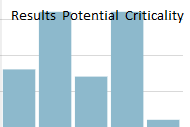Many organizations are ditching Bell curve for performance management. The observation by Gauss became a religion. The the good Bell curve went bad. After seeing that using it has become counterproductive, many organizations are getting rid of forced ranking. 
It should be the dawn of fair world, right? There are good reasons for differentiation and unfortunately they may come with unfair constraints.
First, there is need for differentiation interms of money
Money is a limited resource – There need to be a system to “unevenly distribute” these.
Why uneven? Well. There is always fight for top talent. In any given industry, there are few major players. All organizations would have some or the other crises to resolve. They are willing to pay premium to get talent. i.e. talent has opportunity waiting outside.
In industries in steady state, pay hike may be lower – like 0.5%. But knowledge industries with high growth and HR volatility, pay hike is a big deal and could be 20-30%. Doing this in reasonable way, needs a scalable way. That means – you need performance rating.
All departments would have HR budgets for paying salary, to allocate pay hikes etc. HR may allocate budget based on current overall HR cost as overall percentage. The manager needs to allocate pay hikes within that cost. If it is evenly distributed some guys are likely to leave. If this set of people include your top talent or critical people, then you have an issue. You would need to use brain, understand how to survive another year to retain the critical people. For this, some people may need to be paid higher than average. To balance it, you would need to cut the pay hike. In short, you would need to do differentiation.
i.e. you would need performance rating and also differentiation. If management bandwidth is too short, then fall back to percentage bands of some kind instead of analyzing every individuals case. This could remain an unfair game.
Second, there is need for differential rating for ‘promotability’ and others aspects
Like money, one of the things that excite people is higher responsibility and the power that comes with it. As a popular concept, one way to measure career growth is increased responsibility and title.
How to promote someone? Large organizations need metrics of some kind to justify the promotion or denial of it to someone.
If it is not performance appraisal, there would be other tools like – potential assessment score.
In the end – you would have one or more rating number under your name whether you like it or not. Whether you are aware of it or not.
Third, employees demand differentiation
Employees who perceive themselves as high performers want assurance that they get something that others do not. They want clear differentiators.
There are times, the success is teamwork. But there are also times, ‘heroes’ rescue the organizations. Hence these heroes need acknowledgement of their heroism.
Forth, differentiation is built-into the subconscious minds of management.
There are principles like 80-20 which are different forms of bell curve. There are managers who swear by 80-20 principle. Some of these may wrongly or rightly extend the principle to performance management. Whoever are perceived as the best 20% of the team, get almost everything. Now the politics begin to convince the management that they indeed are the best.
The managers might have subconscious preference for certain personality types.
Some managers may consider the outgoing loudmouths with lot of confidence as best performers. There are also managers who believe that the quiet ones are the workers. The actual performers may not fit into any of the personality stereotypes. But uninformed managers go by their subconscious preferences of personality templates.
Even when there is no organization mandate for differentiation, managers would still force it.
What could organizations do (irrespective whether curve force-fitting is done or not)
1. Management needs to have highly qualified managers. The managers should have past accomplishments in work similar to the subordinates. Also they should have ability to review from higher-level and have right intuition by looking at the overview. (How to find and recruit them is a different question!)
Nothing can substitute for the common sense of the well-informed manager.
2. Make sure that all accomplishments are recorded. Do not let self appraisal scores. But let all the accomplishments be recorded. May be like every month. Once the base data of results are commonly understood, performance evaluation discussion may be lot smoother.
3. Watch Metrics Creation: Large organizations need ways to normalize details. There are too many different kinds of roles and expectations across the organizations. HR needs to have normalized way of seeing things. Hence details-to-metrics conversion is imperative.
Wherever there are details – to – numbers conversion, senior management could review the same. Do random checks on how well managers gather data about subordinates’ work and how output is translated to various performance and potential indicators.
4. Be little skeptical – Irrespective of the rating process improvements, the system will continue to be messy. Believing that improvements make it a perfect system and relying on it for too many HR processes would be a bad idea.
Some skepticism on part of both employee and organization would help to avoid disillusionment.


[…] review the work, provide feedback? Relying on others feedback is not enough. As I stated ‘Bell curve still exists even after getting rid of it‘. Manager needs to develop the normalized view of all his […]
[…] curve is gone from public eye for the most part, though it exists. 80-20 rule will continue to be used and abused to discredit […]
[…] of the ‘corporate culture’. Bell curve is gone from public eye for the most part, though it exists. 80-20 rule will continue to be used and abused to discredit […]
[…] The companies say they do not have mandatory Bell curve now. But it exists in the background. […]